
Feb. 9, 2023—Brightly colored red, yellow or green boxes with a heart and the letters “AED” on them are in many public places. Knowing where they are—and what they do—can enable you to save someone who is having a cardiac arrest.
AEDs save lives
An automated external defibrillator, or AED, is an easy-to-use medical device. It delivers an electrical shock to restart a stopped heart or correct an irregular heart rhythm. It monitors the heart and won’t give a jolt unless needed.
It uses voice prompts and clear instructions so that anyone—including a child—can successfully use an AED. 911 telephone operators can talk you through it too.
If someone collapses and they are not breathing or they are gasping for air:
- Call 911 right away.
- Start CPR while waiting for help to arrive. Don’t stop to look for an AED. Send someone else to find one and bring it to you.
- Open the AED box. Some devices must be turned on, while others power up when you open the lid. Once the device is on, follow the voice prompts to place the sticky electrode pads onto the person’s chest.
- If a shock is needed, the machine will tell you to push a button or announce that it’s about to automatically deliver a shock in order to return the heart to a normal pumping rhythm. Stay clear, and don’t let anyone touch the person.
- The AED will tell you when to resume CPR.
Note: Adult pads can be used on people ages 8 and older. Younger children will need an alternate placement of pads or pads made for them.
Be prepared
Today’s average response time to a 911 call is 8 to 12 minutes. For each minute of delay, the odds of survival during cardiac arrest drop by about 10%. Truly, every minute counts.
If you want to be ready in an emergency to help someone who has collapsed, why not get certified in both CPR and AED use? Classes are offered in person and online.
Sources
- American Academy of Pediatrics. "How to Use an AED." https://www.healthychildren.org/English/health-issues/injuries-emergencies/Pages/Using-an-AED.aspx.
- American Heart Association. "5 Things to Know About AEDs After a Defibrillator Helped Save Damar Hamlin." https://www.heart.org/en/news/2023/01/17/5-things-to-know-about-aeds-after-a-defibrillator-helped-save-damar-hamlin.
- American Red Cross. "What is AED?" https://www.redcross.org/take-a-class/aed/using-an-aed/what-is-aed.
- U.S. Food and Drug Administration. "How AEDs in Public Places Can Restart Hearts." https://www.fda.gov/consumers/consumer-updates/how-aeds-public-places-can-restart-hearts.